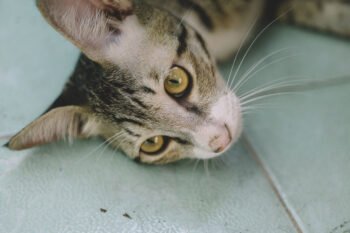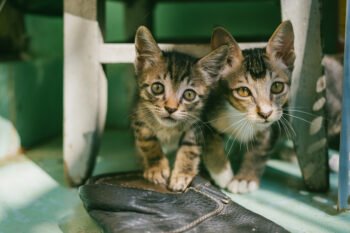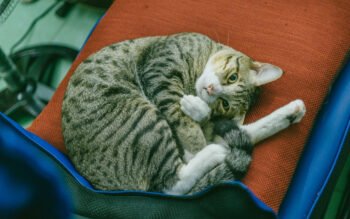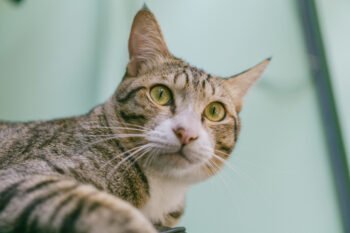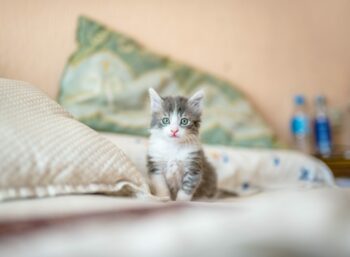King Wu of Zhou the Fifth and Empress Li Lihuana, now living in Philadelphia, Pa., were recently joined together at a joyous celebration that was followed by much speculation as to when they might start a family. Their adopted relatives at least were assured the pair had a good chance of siring healthy offspring. You see, this was a coupling of Himalayan cats and not royal humans, and their relationship had already received a veterinary thumbs up, thanks to new breakthroughs in feline DNA research.
Perhaps the biggest boost in this scientific field was the recent announcement that the domestic cat genome was sequenced. But what exactly does that mean, and how could it affect you and your cat now and in the future?
The ABC’s of DNA
DNA is like a somewhat secretive code made up of words that consist of only four letters: G, C, A and T. Like lottery numbers, the letters combine in all sorts of different ways in the genome, which is an individual’s full set of DNA. Each “word” contains instructions that help to make and run each and every cell in the living creature’s body. The individual could be a human or all other species on the planet, including your cat.
“Cats are the greatest predators that ever lived,” says Stephen O’Brien, PhD, who led the Cat Genome Project. Dr. O’Brien, a scientist at the U.S. National Cancer Institute in Bethesda, Md., and a feline fancier himself was thrilled when he and his team recently announced that the domestic cat genome had at last been sequenced. He explains that he and his team identified the order of the DNA words, or building blocks, which was like “decoding” the secret genetic recipe for what makes up a cat. The arduous process entailed the identification of a whopping 20, 285 genes in the feline genome, proving that cats are indeed complex critters.
Immediate Benefits
As exemplified by the planned, guilt-free joining of the two Himalayan cats from Philly, pet owners like you can already benefit from the DNA secret code unravelings. Randall Smith, spokesman for DDC Veterinary, a division of DNA Diagnostics Center in Fairfield, Ohio, oversaw King Wu of Zhou’s DNA paternity testing. “Breeders like his owners, who wish to remain anonymous, are really fueling advances in this field,” Smith says. “If an animal is a purebred, we can help to confirm and trace back its family lineage, but there are big health benefits too.”
Smith explains that his laboratory also tested the royal, handsome feline for a deadly disorder among Himalayan, Persian and other exotic cats called polycystic kidney disease, or PKD. This inherited disease causes cysts to form on a cat’s kidneys. Eventually PKD may lead to a painful death. King Wu’s tests came back completely negative, meaning that neither his father nor his mother carried the PKD gene, so he’s now good to go for breeding umpteen litters of PKD-free kittens, so long as his mates also test negative.
PKD is the primary DNA health-related test for felines now, but Smith predicts that others will soon be possible. “Cats have been slow to come on to DNA testing, perhaps because more dogs are purebreds and are easier to study for genetically inherited disorders,” he says. “But advances likely will come very quickly, since many hereditary disorders in felines mirror similar ones in people.”
Cats May Benefit Human Health
One amazing realization made possible through the recent advances in genetics is how similar cats are to humans on the DNA level. In fact, all mammals that have had their genomes deciphered — cows, dogs, mice, chimpanzees, rats and more — share similar chromosomes, which are the specialized structures that hold genes in each cell. For researchers, such comparisons are like analyzing the primary ingredients of a bunch of different cookies. One may be peanut butter and another chocolate chip, but the basic formula remains the same, so they’re all cookies. In this case, a comparable formula encodes for all mammals.
Because of the cellular similarities, cats and humans can suffer from similar health problems. In fact, Dr. O’Brien says domestic cats possess over 250 naturally occurring hereditary disorders, many of which are similar to genetic pathologies in us. For example, cats may inherit a genetic mutation that causes retinitis pigmentosa, a degenerative eye disease that can lead to blindness in both people and felines. Thanks to the recent cat genome work, Dr. O’Brien and other scientists are on the road to finding a cure for this debilitating disease.
Hereditary diseases aren’t the only ones that might experience cures in the future due to the DNA findings. Cats can also suffer from infectious diseases that are very similar to HIV/AIDS. One feline virus, called FIV, is a genetic relative of HIV. Dr. O’Brien is hopeful that studies on FIV and another immunodeficiency cat virus, FeLV, could one day lead to cures for both AIDS and even leukemia, which also targets both feline and human immune systems.
How Can You Prepare for the Future?
Like a child, your cat is a longtime family investment, so you are probably in it for the long haul in terms of your feline’s health. While paternity and PKD tests are already available, you might wish to be prepared for future DNA tests that might happen in the months and years to come. Animal DNA Laboratory in Melbourne, Australia, and DDC Veterinary actually can store a DNA sample from your cat in environmentally controlled banking facilities. That way, you’ll have a genetic fingerprint for your cat on file, and you’ll be ready when future health screenings become available.
Smith explains that the process is like the DNA cheek swabs commonly shown on television detective shows. The cells on the inside of the mouth frequently shed, so they are easy to collect. Here are the steps DDC recommends:
1. Fill out the laboratory’s requested health information about your cat.
2. Open the provided package and remove the Q-Tip-like swab. It has a plastic handle so it’s important to touch only the handle and not the cotton, so as to not contaminate the sample with your own DNA!
3. Hold your cat by the scruff with one hand and place the swab into your cat’s mouth, so that the swab brushes against the inside surface of your cat’s cheek.
4. Twirl the swab there for several seconds. The goal is to capture loose cheek cells and not saliva.
5. Immediately insert the swab into the provided special envelope.
6. Repeat the process with other provided swabs.
7. Mail the whole thing back to the laboratory.
While your cat may squirm, the process is simple and relatively painless. In the future, biochips containing copied cells from the provided samples may allow you to test your cat for all sorts of diseases and conditions. You may also be able to test your cat out on medicines and other products, like shampoos, to see which ones, and in what amounts, might best work for your feline. “It’s difficult to speculate on what exactly will be possible,” Smith says, “but scientific teams at universities and other facilities are making new discoveries all of the time. The future for genetic research looks incredibly bright.”

